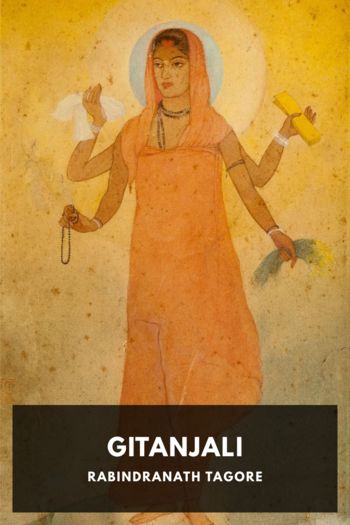My Reminiscences - Rabindranath Tagore (best ereader for pc txt) 📗

- Author: Rabindranath Tagore
Book online «My Reminiscences - Rabindranath Tagore (best ereader for pc txt) 📗». Author Rabindranath Tagore
A jingling sentence in the Bengali Child’s Primer. ↩
Exercises in two-syllables. ↩
Roofed colonnade or balcony. The writer’s family house is an irregular three-storied mass of buildings, which had grown with the joint family it sheltered, built round several courtyards or quadrangles, with long colonnades along the outer faces, and narrower galleries running round each quadrangle, giving access to the single rows of rooms. ↩
The men’s portion of the house is the outer; and the women’s the inner. ↩
These Bustees or settlements consisting of tumbledown hovels, existing side by side with palatial buildings, are still one of the anomalies of Calcutta. —Tr. ↩
Corresponding to “Wonderland.” ↩
There are innumerable renderings of the Ramayana in the Indian languages. ↩
A kind of crisp unsweetened pancake taken like bread along with the other courses. ↩
Food while being eaten, and utensils or anything else touched by the hand engaged in conveying food to the mouth, are considered ceremonially unclean. ↩
The writer is the youngest of seven brothers. The sixth brother is here meant. ↩
Obsolete word meaning “bee.” ↩
The lane, a blind one, leads, at right angles to the front verandah, from the public main road to the grounds round the house. ↩
God of Death. ↩
Goddess of Learning. ↩
The Jupiter Pluvius of Hindu mythology. ↩
The King of the Yakshas is the Pluto of Hindu mythology. ↩
Corresponding to Lethe. ↩
Krishna’s playground. ↩
Correspondence clerk. ↩
Spices wrapped in betel leaf. ↩
It is considered sinful for non-Brahmins to cast glances on neophytes during the process of their sacred-thread investiture, before the ceremony is complete. ↩
Two novices in the hermitage of the sage Kanva, mentioned in the Sanskrit drama, Sakuntala. ↩
The text for self-realisation. ↩
Bards or reciters. ↩
The Cow and the Brahmin are watchwords of modern Hindu orthodoxy. ↩
An instrument on which the keynote is strummed to accompany singing. ↩
A large proportion of words in the literary Bengali are derived unchanged from the Sanskrit. ↩
Servants call the master and mistress “father,” and “mother,” and the children “brothers” and “sisters.” ↩
Name of Vishnu in his aspect of slayer of the proud demon, Madhu. ↩
Nirada is a Sanskrit word meaning “cloud,” being a compound of nira = water and da = giver. In Bengali it is pronounced nirode. ↩
Betel-leaf and spices. ↩
Father of the well-known artists Gaganendra and Abanindra. —Ed. ↩
In Bengali this word has come to mean an informal uninvited gathering. ↩
Systems of notation were not then in use. One of the most popular of the present-day systems was subsequently devised by the writer’s brother here mentioned. —Tr. ↩
The new bride of the house, wife of the writer’s fourth brother, above-mentioned. —Tr. ↩
It may be helpful to the foreign reader to explain that the expert singer of Indian music improvises more or less on the tune outline made over to him by the original composer, so that the latter need not necessarily do more than give a correct idea of such outline. —Tr. ↩
This would mean “the genius of Bhubanmohini” if that be taken as the author’s name. ↩
Gifts of cloth for use as wearing apparel are customary by way of ceremonial offerings of affection, respect or seasonable greeting. ↩
The old Vaishnava poets used to bring their name into the last stanza of the poem, this serving as their signature. Bhanu and Rabi both mean the Sun. —Tr. ↩
The dried and stripped centre-vein of a coconut leaf gives a long tapering stick of the average thickness of a match stick, and a bundle of these goes to make the common Bengal household broom which in the hands of the housewife is popularly supposed to be useful in keeping the whole household in order from husband downwards. Its effect on a bare back is here alluded to. —Tr. ↩
There was a craze for phrenology at the time. —Tr. ↩
Latterly Sir Tarak Palit, a lifelong friend of the writer’s second brother. —Tr. ↩
Saraswati, the goddess of learning, is depicted in Bengal as clad in white and seated among a mass of lotus flowers. —Tr. ↩
With Indian music it is not a mere question of correctly rendering a melody exactly as composed, but the theme of the original composition is the subject of an improvised interpretative elaboration by the expounding artist. —Tr. ↩
Valmiki Pratibha means the genius of Valmiki. The plot is based on the story of Valmiki, the robber chief, being moved to pity and breaking out into a metrical lament on witnessing the grief of one of a pair of cranes whose mate was killed by a hunter. In the metre which so came to him he afterwards composed his Ramayana. —Tr. ↩
Some Indian classic melodic compositions are designed on a scheme of accentuation, for which purpose the music is set, not to





Comments (0)